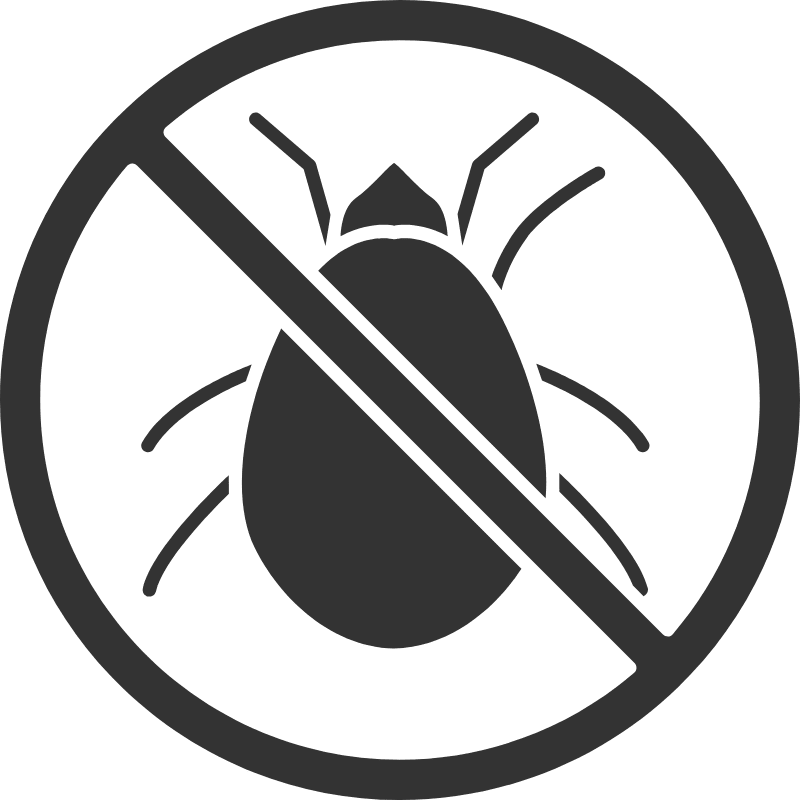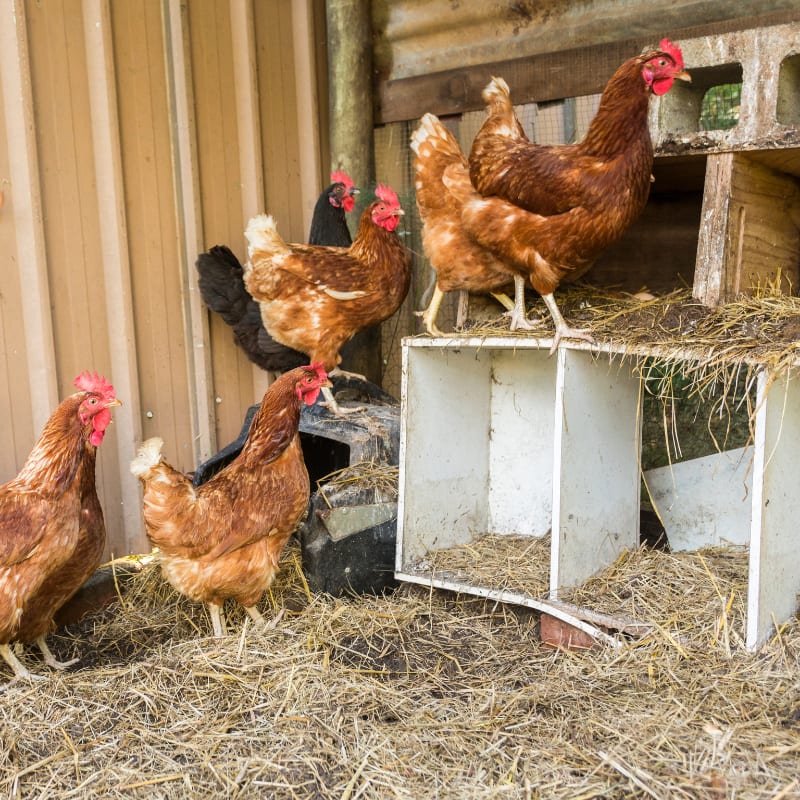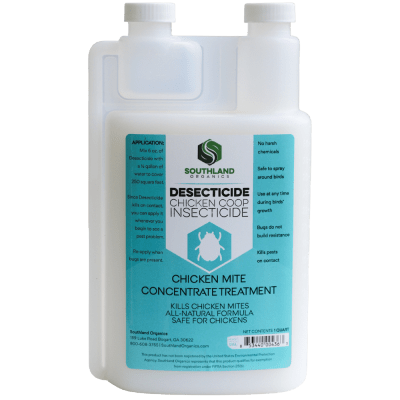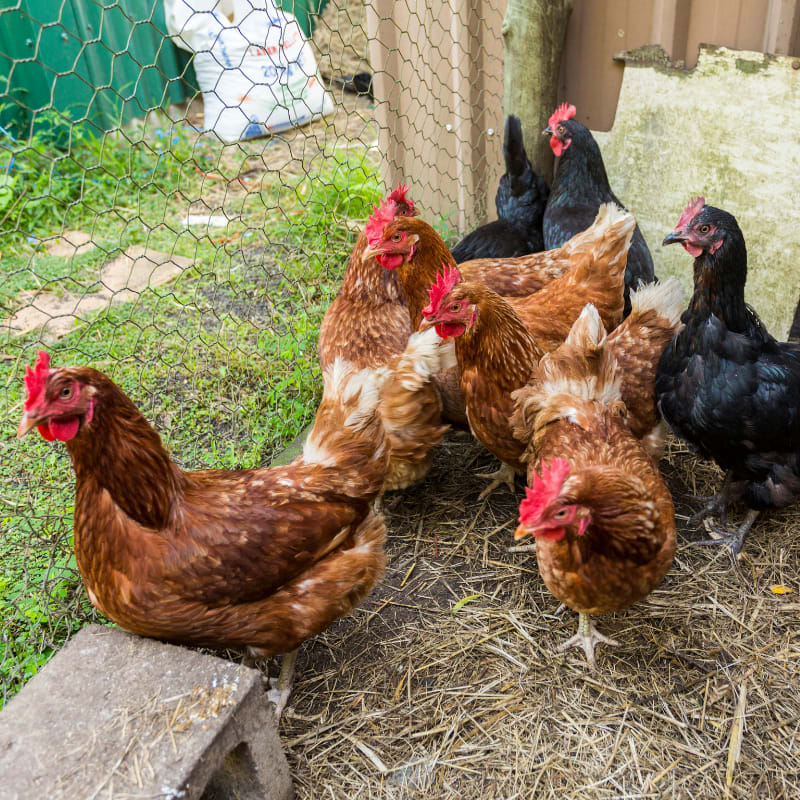Chicken mites go by many different names: Northern fowl mites, scaly leg mites, poultry mites, red mites, red roost mites, red chicken mites… Whatever you call them, we know one thing for sure- No mite on a chicken is a good mite! Let's talk about how to get rid of chicken mites.
A chicken mite infestation can be daunting, not to mention kind of gross, to handle. On top of being annoying, these tiny bloodsuckers can pose a serious threat to the health of your chicken coop. But don’t panic- In this blog, we’re going to talk about how to identify chicken mites, how to prevent chicken mites and how to get rid of them without harsh chemical treatments.
What are chicken mites?
Chicken mites feed on blood to survive, making them external parasites. Typically, it only takes 7-10 days for a mite egg to become an adult. Plus, they can lay up to 100,000 mite eggs in their life cycle. This means a lot of mites in a little time!
Once fed, an adult mite can survive without feeding again for another 4-5 months. Different mites live best in different temperatures, so be on the lookout for chicken mites year-round. Many species remain on their host bird for their entire lives, only moving hosts if the bird dies.
In this blog, we’ll mostly talk about chickens. However, it should be noted that if you have any other birds in your backyard, like ducks, turkeys or peacocks, this information is equally applicable! These birds can suffer from mite infestations too, and can be treated by similar methods as chickens.
Types of Chicken Mites

Like we mentioned, there are several different types of chicken predator mites. They are very similar in how they’re identified, prevented and treated, so we will talk about them generally here. Below is a quick breakdown of the different types of mites that can feed on chickens in your backyard.
Scaly Leg Mites
The scaly leg mite is pretty aptly named. They live underneath the scales on chickens’ feet and can make a chicken’s legs look crusty. These mites cause pain specifically in the feet.
Northern Fowl Mite
Northern fowl mites are some of the most common mites to find in an infestation. According to Poultry DVM, they can potentially cause chickens to lose about 6% of their blood each day of an infestation. You can even see signs of a northern fowl mite when hens lay eggs that have blood spots on them!
Red Mite
Unlike other mites, red mites are nocturnal. They can hide in a chicken coop during the day, only emerging at night to feed on your birds. They also have a longer life cycle, around 2 weeks as opposed to 5-7 days.
Poultry Lice
Lice and mites are similar in that they externally feed on chickens and cause them discomfort and vulnerability. However, lice are not blood feeders- Instead, they feed on skin, feathers and scales. Their life cycle is 1-2 weeks long, and a lice infestation is usually caused by direct contact between chickens or infected equipment.
How do mites threaten a chicken coop?
Chicken mites are parasites, which are never beneficial to their hosts. They bite chickens and feed on their blood, just like a tick or mosquito might do to us humans. When mites feed on your birds, it makes them uncomfortable and causes unnecessary stress. According to the University of Kentucky, this stress makes them more susceptible to other issues, like diseases, anemia and reduced egg production. And that’s the last thing we want!
Some even believe that chicken mites can carry pathogens that cause diseases from chicken to chicken. While chicken mites cannot infest humans, they can bite them and cause skin irritation and itchiness.
How to know if you have Poultry Mites
Hundreds of thousands of mite bites can take place before you realize you have a mite-infested chicken coop. Identifying signs of poultry mites can help you know when to take action before the infection worsens.
Symptoms of a mite infestation can include:
- Feather loss
- Fewer eggs
- Blood smears or dark dots on legs and skin
- Reluctance to go to nesting boxes
- Blood spots on eggs
- And of course, finding mites on chickens or the chicken coop
If the weather is warmer, you may want to look for red mites. This can include

going into your coop at night and checking for bugs, especially on roosting perches. If you run your hand along the perches and see blood on it afterwards, you probably have mites in your coop. It can also be helpful to shine a light under your birds’ wings and their vent area at night, when mites will be easier to spot.
Also, check yourself! While chicken mites cannot live on humans long-term, they can bite you and cause you to itch. If you’re facing skin irritation after being in close contact with your birds, an infection might be present.
How to prevent mites
Although there’s no way to completely prevent mites and ensure your birds never get infected, there are some measures you can take to repel mites so they are less likely to inhabit your coop.
Where do these mites even come from? Other animals like rodents, wild birds and even pets can carry mites to your chickens. Try to keep your coop free from unnecessary wild animals, and avoid wild birds coming in. If you have pets the regularly interact with your birds, that’s great! Just be sure to check your pets regularly for mites or other pests that they may transfer to your chickens.
Since mites can live without a host once fed, equipment can also be infected and bring mites to your chickens. If you see some suspicious-looking insects on your equipment, clean it thoroughly away from your chickens.
Beyond exposure reduction, it’s important to constantly keep your coop clean and regularly check your chickens for infection. We know this is an obvious chore for chicken keepers, because you love having healthy chickens! But keeping in mind the possibility of mites when cleaning can help you catch them before an infestation worsens.
Chickens’ regular preening habits can help prevent mites! Also, chickens taking dust baths can help. A dust bath area is typically made of a dry patch of sand or dirt. Some chicken keeping experts recommend adding wood ash or food grade diatomaceous earth to dust baths. This is because diatomaceous earth and wood ash absorb the moisture from pests’ bodies, causing them to dry up and die.
However, in hot, humid or rainy conditions, it might be difficult to have a dry enough dust bath to completely battle mites. Some spray the chickens themselves with garlic juice to prevent mites too. While these methods can be great to deter mites, pest control measures are necessary to truly get rid of a mite infestation.
How to Get Rid of Chicken Mites
Poultry mites will not just go away on their own. It takes deliberate action to treat mites and kill them. But killing mites doesn’t have to hurt your chickens! While there are plenty of insecticide products with harsh chemicals, we do not recommend them for use in your coop. It’s totally possible to eradicate mites naturally!
To fully get rid of mites, you’ll need to treat your coop meticulously. Organic disinfectants can be used for cleaning equipment and materials, and coop bedding will need to be burned (outside of the coop, of course) and replaced with new bedding.
Some folks like to make a mite spray on their own with ingredients like cooking oil, soybean oil, or vegetable oil and dish soap. This spray can help suffocate bugs and kill them. This method certainly will not hurt your chickens and should help kill mites. However, in a full infestation this oil spray likely will not be enough to do the trick and totally get rid of mites.
But how can you really get mites off your chickens and their coop safely? We’re proud to offer an all-natural spray that actually kills mites and other pests and is completely safe for chickens.
Natural Coop Mite Spray
Desecticide is a highly effective pest killer that is completely non-toxic for chickens, humans and pets. But boy is it toxic for mites! Desecticide targets neurological receptors active only in insects and arthropods to kill mites and other insects. Mites are a huge problem in backyard chicken coops, but with Desecticide you’re also covered for darkling beetles, lesser mealworms, bed bugs, fleas and ticks.
On the packaging, you’ll see that Desecticide is “specifically formulated for darkling beetles.” We originally made this product for commercial poultry houses, where darkling beetles are the main pest issue. Because of this, we typically market this product as a darkling beetle insecticide.
Desecticide is an amazing insecticide for darkling beetles, but it is just as effective on mite populations. We know that for backyard chicken keepers, mites are the primary pest concern. While homemade remedies can help out, they really can’t eliminate a mite infestation like Desecticide can. And while traditional pesticides can be effective, they can hurt your chickens, wildlife and the environment.

One of the best benefits of Desecticide is that you can spray it in your coop while birds are present. No need to worry about taking them out and making them wait before returning to their home! Your feathered friends will be completely unbothered by this pest control spray.
Desecticide is effective in 24 hours, so you can get rid of your infestation quickly. Bugs can’t build resistance to Desecticide, and there is no-reapplication limit. So you can use Desecticide until your mite problem has been solved. Plus, Desecticide is safe for the environment, so no need to worry about your garden, plants or lawn being hurt by it.
Desecticide can be applied easily by you- no professional services needed! To get rid of mites and more, simply apply 6 ounces of Desecticide per ½ gallon of water and apply with a sprayer. This should cover 250 sq. ft.
The next instruction is especially important. When mixing, start with the water first, and then add in Desecticide. If you add the water to the Desecticide instead, you will get a foam.
Spraying Desecticide on your coop floor will kill mites so that they can't prey on your birds any more.
Contact Us
I hope you found this helpful! I’d love it if you never experience mites in your coop, but if you do, Desecticide is a great way to effectively get rid of them without threatening your chickens’ health. If you have any questions, reach out to us at 800-608-3755 or email izy@southlandorganics.com.
Check out Desecticide here, and find other safe and effective poultry products like Hen Helper and Big Ole Bird on our YouTube page and blog!







